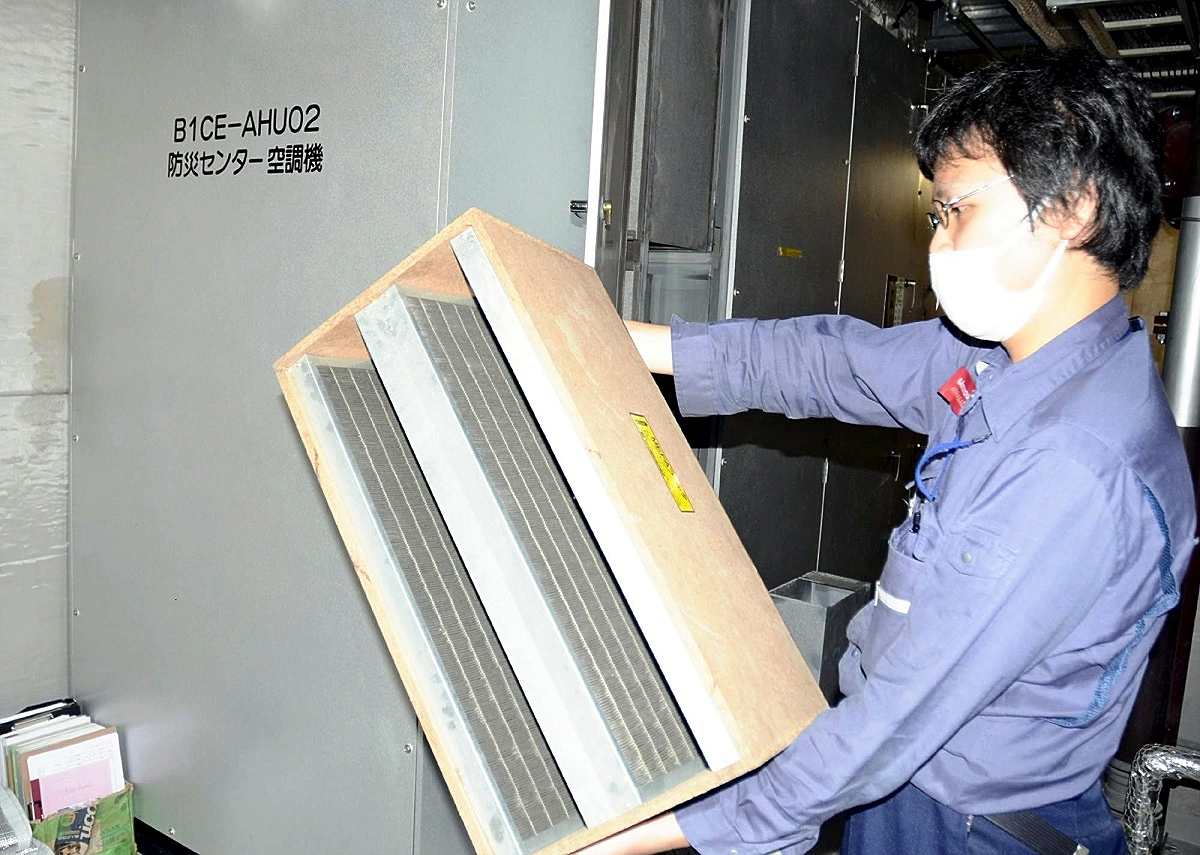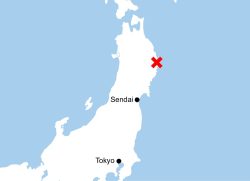Tokyo Companies Prepare for Ashfall From Mt. Fuji Eruption; Disposal Of Ash, Possibly at Sea, A Major Challenge

A great amount of ash is expected to fall in central Tokyo if Mt Fuji, seen here from Tokyo’s Taito Ward in 2023, erupts in the future.
1:00 JST, September 6, 2024
A potential future eruption of Mt. Fuji could blanket Tokyo and the surrounding region in a layer of volcanic ash, and some companies and municipalities are ramping up their preparations.
Companies are inspecting the equipment in their office buildings and municipalities are developing guidelines for dealing with ashfall, but methods for disposing of great amounts of ash still need to be sorted out. The government plans to consider various methods, including dumping it into the ocean.
Rising interest
Mitsubish Estate Co., a major real estate company based in Tokyo, has been proactively addressing the risks of ashfall across about 20 buildings it owns around the city’s Marunouchi area, including the Marunouchi Building near Tokyo Station, since 2021.
In 2020, the central government released an estimate of the potential ashfall from a Mt. Fuji eruption. Based on that, the company anticipates the accumulation around Marunouchi could reach up to 10 centimeters, and has prepared spare filters to address potential clogging of air conditioners caused by volcanic ash. A timeline outlining how employees and visitors should respond to a potential eruption and ashfall has also been developed.
A representative of the company said: “It will be too late to respond only after the eruption occurs. We want to ensure thorough preparation so that people inside the facility can act safely.”
A representative of Sompo Risk Management Inc., a consulting firm in Tokyo, said, “Companies are increasingly focusing on measures to prepare for a potential eruption of Mt. Fuji.” The company in February has launched a service to help other companies take measures against volcanic ash. It offers seminars to learn about the effects of ashfall and how to make reports on the impact on facilities, as well as game-like drills to experience how to respond before and after an eruption.
The Sompo representative said: “There are many things to consider such as deciding whether employees go home or stay at the company and securing alternative facilities. We want to support companies so they can operate even in the worst scenario.”
The guideline

A filter that has been prepared in case air conditioners become clogged by ashfall in Tokyo’s Marunouchi area, seen on Wednesday.
Municipalities in Tokyo and surrounding areas have also begun taking measures. The Tokyo metropolitan government developed response guidelines for a potential ashfall from a Mt. Fuji eruption last December. It provides response benchmarks for action, such as taking shelter indoors if ash accumulation reaches to 2 to 30 centimeters and evacuating the area in case of ashfall reaching 30 centimeters and when it rains, due to the risk of wooden houses collapsing.
However, methods to dispose of ash that will accumulate on the street still needed to be sorted out. The guidelines say that routes serving public organizations and medical institutions must be designated in advance, and priority will be given to removing volcanic ash from one set of tracks in each direction for these roads. However, disposal sites have not been decided yet.
The representative of the Tokyo metropolitan government said, “We cannot dispose such an amount of ashfall in Tokyo.” In June, the Kanto region governors’ association urged the central government to formulate guidelines on how to deal with ashfall and to set operating standards for public transportation, saying, “It is difficult for Tokyo and surrounding prefectures to deal with wide-area damage caused by ashfall by themselves.”
Consider impact on environment
As a result, the government has begun considering measures. In late July, an expert panel was launched to address potential ashfall in Tokyo and surrounding areas. It plans to develop guidelines by the end of the year for protecting citizens, forecasting wide-area ashfall and disposing of ash. In the first meeting, several safety measures in accordance with the amount of ashfall were proposed: in principle, evacuate if ash accumulation reaches 30 centimeters or more; consider evacuation for ash levels of 3 centimeters or more, depending on the situation; and continue living within the area for lesser accumulations.
At the next meeting to be held this month, volcanic ash management, including securing temporary storage sites and disposal facilities, as well as exploring the possibility of ocean dumping, will be considered. The law prohibits dumping waste in the ocean except when the Environment Ministry identifies an emergency need. A government source said, “We need to carefully consider the issue with the impact on the environment and ecology in mind.”
Related Tags
"Society" POPULAR ARTICLE
-

Tokyo Zoo Wolf Believed to Have Used Vegetation Growing on Wall to Climb, Escape; Animal Living Happily after Recapture
-

Israeli Tourists Refused Accommodation at Hotel in Japan’s Nagano Pref., Prompting Protest by Israeli Embassy and Probe by Prefecture
-

Tsukiji Market Urges Tourists to Avoid Visiting in Year-End
-

Snow Expected in Tokyo, Neighboring Prefectures from Jan. 2 Afternoon to Jan. 3; 5-Centimeter Snow Fall Expected in Hakone, Tama, and Chichibu Areas
-

Tokyo, Yokohama Observe First Snowfall of Season; 1 Day Earlier than Average Year
JN ACCESS RANKING
-

As Chinese Tourists Shun Japan, Hotels and Stores Suffer
-

Osaka-Kansai Expo’s Economic Impact Estimated at ¥3.6 Trillion, Takes Actual Visitor Numbers into Account
-

Japan Govt Adopts Measures to Curb Mega Solar Power Plant Projects Amid Environmental Concerns
-

BOJ Gov. Ueda: Highly Likely Mechanism for Rising Wages, Prices Will Be Maintained
-

Economic Security Panels Debate Supply Chains, Rare Earths; Participants Emphasize Importance of Cooperation Among Allies
























